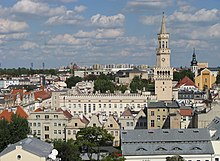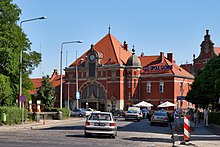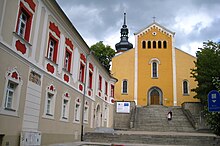Opole is the capital city of Opole Voivodeship, in south west Poland. The historical capital of Upper Silesia was badly damaged during the USSR invasion of Silesia at the end of World War II, but many fine houses in the old town have been rebuilt. The city is known for the one of the most popular song festivals in Poland, which takes place each year in June.

Understand
editOpole is one of the oldest cities in Poland, continuously inhabited since the 8th century and quickly becoming an important centre of power, defense and trade. It is considered the historical capital of Upper Silesia, being much older than cities like Katowice, which grew rapidly only during the industrial revolution of the 19th century.
Opole has been a capital of its own Duchy carved out of Poland in the 13th century, when the Polish Piast dynasty started dividing the country into local hereditary fiefdoms. This lasted until the 16th century, when the dynasty died out and a complicated history of the city and region changing hands begun, with it ending in Prussia and later the German Empire, with Germans becoming the majority. After the Second World War, Opole was given to Poland and much of the local German population expelled.
With less than 120,000 inhabitants, Opole is now the smallest city to be a regional capital in Poland by population, and its voivodeship has the smallest population as well.
Get in
editBy plane
editThe nearest international airports are in the nearby cities of Katowice and Wrocław.
From Katowice Airport and Wroclaw Airport to Opole, there is aaeroBUS.pl bus with door2door service.

By train
editThe city's main train station is 1 Opole Główne, situated on a railway mainline to Wrocław. It sees busy long-distance and local traffic, including Express Intercity Premium trains. Travel time varies depending on the class of train, with the shortest time needed to get to major direct destinations from Opole being:
- Wrocław - 45 minutes
- Częstochowa - 50 minutes
- Katowice - 1h15mins
- Wałbrzych - 1h40mins
- Kraków - 2h25mins
- Jelenia Góra - 2h40mins
- Warsaw - 3 hours
- Rzeszów- 5h40mins
- Szczecin - 6 hours
See the PKP Intercity interactive timetable for details on trains and times.
By car
editBy bus
editOpole has seen many of the inhabitants of the city and the region emigrate temporarily or permanently to Western Europe seeking better-paid jobs, especially concerning low-skilled, manual labour. Therefore, an extensive network of affordable coach services grew to cater to their travelling needs. Moreover, express bus travel has seen much growth in the 2010s in Poland and Opole is featured in many timetables of local operators.
- One of the largest coach operators in Poland, Sindbad, is based in Opole and thus the city features in many of their timetables
- PolskiBus runs a connection via Opole from Berlin and its Schoenefeld Airport through Wrocław further to Katowice, Kraków and Zakopane. The journey from the farthest ends of the route to Opole takes 5 hours.
Get around
editBy public transit
editOpole's public transit is limited to buses, operated by MZK Opole. Its website has sloppy English integration with Google Translate. A single 45-minute/one-ride ticket costs 4.20 zł (2.10 zł for students and children), and a 24h ticket comes at 13 zł (6.50 zł reduced). There is a plethora of other ticket types that are generally not that useful for a casual traveller, but it is important to remember that a different (higher) tariff applies when crossing the city limits on some lines that reach out beyond Opole to neighbouring suburbs.
By bike
editSince municipal bikesharing program has been canceled in Opole in 2021 your only bet at riding a bike in Opole will be if you bring it with yourself or rent one at Decathlon Rent on city outskirts which are hard to reach by bike (about 80 zł per day). In general it is not worth it.
See
edit
- 1 Piast Tower. The sole remainder of a medieval castle built by the local Piast dukes of Opole as a residence and defensive facility. The tower was a late addition, stemming from the 14th century, while the construction of the castle started in 1228. As the former Duchy of Opole started changing hands between surrounding kingdoms and empires, the castle was subjects to periods of ruin and reconstruction. Finally, in 1928, the German authorities deemed the castle to be in poor condition and ordered its demolition to make room for a new government office complex. After much public outcry from the local Polish (at that time) minority, the tower was preserved and remains standing between the modernist buildings, which still serve the regional government of Opole.

- 2 Holy Trinity Church. A 14th century Franciscan church including a Piast mausoleum

- 3 Church on the Hill (Church of the Painful Mother of God and Saint Adalbertus). The church's full name is a mouthful to pronounce, so the locals refer to it by its uphill location
- 4 Town Hall. The neo-renaissance Town Hall is a result of numerous reconstructions and expansions. Especially its tower had a tumultuous history, being rebuilt many times, the last time in 1936, with the aim to resemble Palazzo Vecchio of Venice. Unlike many other town halls of major cities in Poland, the one in Opole is still used for its original function and most of the official business pertaining to the city authorities is conducted inside.
- 5 Train station. Eclectic train station building
- 6 Most Groszowy. The pedestrian bridge with wrought iron railings was constructed at the turn of the 20th century. Crossing the bridge originally cost 1 grosz (smallest currency unit), hence the name. Otherwise, the bridge is called Zielony Mostek (the green bridge), referring to its colour, or Most Zakochanych (lovers' bridge) for the custom of loving couples locking a padlock on the railings to signify their commitment.
- 7 Castle Pond with fountains. The name is a bit misleading as the pond was actually created from the remains of the moat after the castle was demolished. It serves a purely recreational purpose, with an active musical fountain in the summer and a long tradition of ice-skating in the winter, with the pond hosting the German ice-skating championships in 1934. The wooden house with the restaurant was originally erected for the local ice-skating society. The musical fountain performs a lights-and-music show on summer evenings.
- 8 Ceres Fountain, Plac Daszyńskiego.
- 9 Venice of Opole. A wall of historic buildings directly over the Młynówka river looks quite spectacular and nothing like Venice, actually, but more like canals of Hamburg for example. Some of the best photos of Opole are taken there at night.
- 10 Saint Sebastian Church.
Museums
edit- 11 Opole Regional Museum (Muzeum Śląska Opolskiego). Several branches in three different buildings. regular 10 zł / reduced 6 zł.

- 12 Opole Open-Air Museum of Rural Architecture (Muzeum Wsi Opolskiej), ul. Wrocławska 174. regular 14 zł / reduced 7 zł.
- 13 Modern Art Gallery (Galeria Sztuki Współczesnej), pl. Teatralny 12. M-Su 10:00 - 18:00.

- Central POW Museum (Muzeum Jeńców Wojennych) Minorytów 3, M-Fr 8.00-17.00, free entrance
- 14 Song Museum (Muzeum Polskiej Piosenki) (at the Amphiteatre / National Centre of Polish Song).
Do
edit
- 1 National Centre of Polish Song (Millennium Amphitheatre). The most prominent function of the amphitheatre is hosting the annual Polish song festival in June, but it remains busy in the warmer months with other concerts and events
- River cruises.
- Football: Odra Opole play soccer in I Liga, the second tier. Their home ground Odra Stadium (capacity 3300) is 1 km northwest of town centre.
- 2 ZOO. 18 / 12 zł.
- 3 Opole Philharmonic.
Buy
editShopping centres
edit- 1 Solaris Center. A fairly large shopping gallery in the city centre, upscale by local standards, with many of the usual suspects in chain retail (ZARA, promod etc.) A big part is occupied by the Helios multi-screen cinema. Also includes a fairly large electronics store and a sizeable food court filled with fast food options.
- 2 Karolinka. A strip mall on the outskirts anchored by the Auchan hypermarket, featuring many of the stores that would not fit within city centre galleries, including furniture stores and a big Decathlon sporting gear store
- 3 Turawa Park. Another strip mall on the outskirts - actually next to the ringroad and easier to reach from some of the neighbouring villages than the city itself. Anchor tennants are the Carrefour supermarket and Praktiker home improvement store.
- 4 Galeria Opolanin.
- 5 Galeria Ziemowit.
Eat
edit- 1 Manekin. A branch of the Polandwide chain of pancake-and-crepe restaurants, known for their hearty servings and low prices, is located on one of the busiest and also nicest street corners of Opole's old town. Expect a bit of a wait and not leaving hungry
- Sopelek. Opole's leading ice cream parlor chain made a name for itself with an extensive menu of fancy ice-cream-based desserts, all of which are very generous in size. Regular scoop-and-cone ice cream for takeaway is also on offer. Selected locations include:

Drink
editSleep
editBudget
edit- Hostel Opole Główne. The hostel is in the train station building and offers a selection of ensuite rooms and beds in shared dorms. Facilities include paid parking and a cafe Beds from PLN 45, Rooms from PLN 120.
Mid-range
edit- Best Western Hotel Opole Centrum.
- DeSilva Premium Opole. The first large four-star hotel in Opole offers a range of modern comforts, including a fitness centre and a cigar bar
- Hotel Festival, ul. Oleska 86, ☏ +48 77 427 55 55, recepcja@festival.com.pl. The out-of-way location makes it more suitable for those arriving by car, but on the flip side it features a small swimming pool and fitness room. From PLN 169, breakfast included.
- 1 Mercure Opole, ul. Krakowska 57-59, ☏ +48 77 451 81 00, fax: +48 77 451 81 99, H3405@accor.com. Right in front of the train station, which is also where most long-distance buses stop, the Mercure has seen its fortunes slip as more modern hotels opened around town. It is still a commendable option with all the necessary features but air conditioning or any kind of fitness facilities are missing. Low prices make up for that - check on the official website and book in advance to take advantage of frequent special offers. Rates starting at PLN 105, breakfast is PLN 35.
Splurge
edit- Piano Hotel.
- Hotel Starka.
Cope
editGo next
edit- The Castle of Moszna is a fairytale edifice in a beautiful park and a popular day trip destination (half an hour by car from Opole)
- Brzeg, an oft-overlooked historic town in the region, is 20 minutes by train and 40 by car
- Wrocław, a large city rich in history and heritage, is less than an hour by train and a little more by car, making it possible to do a day trip there

